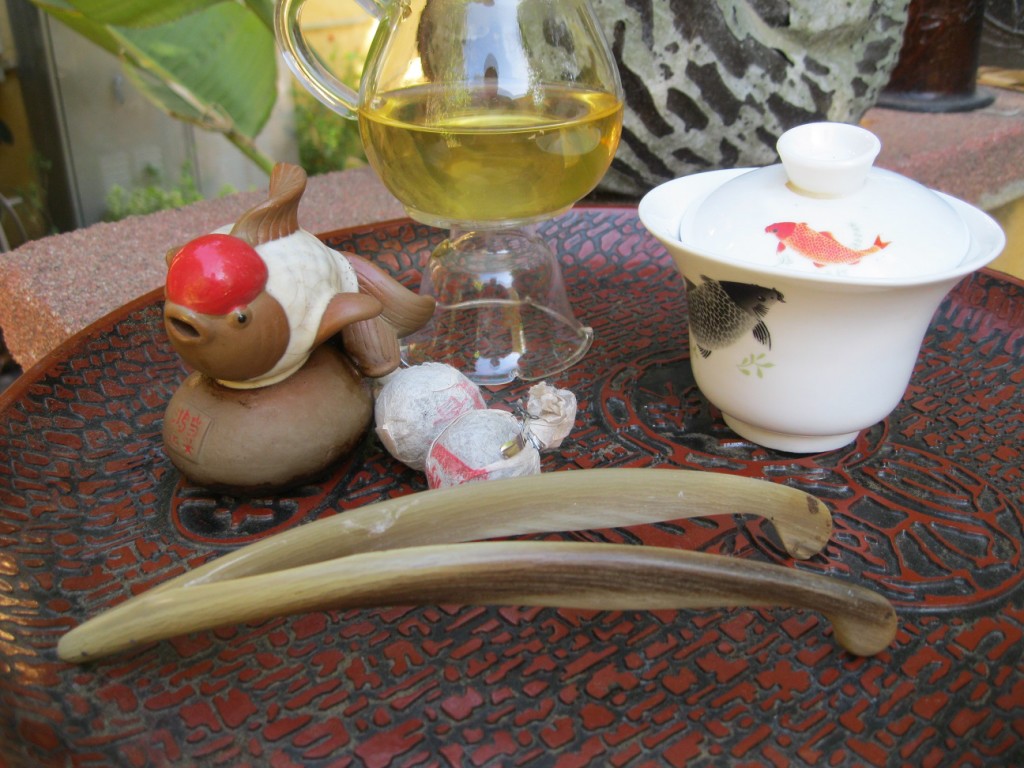Top Pu erhs 2015-’05 III

Let’s continue our discussion. Our top two were Lao Banzhang and Naka. The second two were Bing Dao and Gua Feng Zhai. It should be noted that though these are the veritable “macs” of the pu erh universe, the ensuing terriors are in some aspects of similar repute. We’re as much relating the tastes of the Mainland and HK, as we are relating any bona fide standard. Ultimately, you’ll decide. We proceed now to discuss Wan Gong and Xi Gui .
Wan Gong (Bow Village)
Wan Gong has only slowly come to be recognized over the past few years. A secret for many years, circumstances are now such that it has undergone a most maniacal harvesting. Bow Village was once the center of the ancient Man Sa tea region. According to what the old locals say, before the Xian Feng Emperor (1850-1861) of the Qing Dynasty (1644-1911), the villages of Man Sa Mountain were closely grouped together with a population exceeding 10,000. Greater Bow Village and Man Sa Street were once Yiwu Mountain’s two most flourishing markets. Judging from the ruins of the Guan Di Temple, one can now only imagine the bustling nature of the day. Afterwards, Greater Bow Village slowly declined, slowly losing favor among tea enthusiasts.
Traits: Wan Gong possesses a bright golden liquor. Gentle, the flavor is thick and filling. The aroma is uniquely enchanting evoking a sense of its origins from pristine forests. The saliva- promotion factor is notable and continuous. The throat yun is long-lasting. It possesses a relatively strong brewing strength, which is stable from one infusion to the next.
Impressed by the locale’s name and its history, the pu erh Junky has taken a bit of fancy to Bow Village. It’s a very Zen tea overall. If Lao Banzhang is an epic Hollywood production from the 50s, then Bow Village is an austere Swedish narrative by Ingmar Bergman. The Unwrapped Dragon Pearl is a great place to start. The flavor is true, gentle in both sweetness and astringency. The liquor is bright yellow, if a bit wanting in clarity. The veins in the mostly whole leaves are very pronounced. The soft aroma is identical to its taste, evocative of alfalfa. The Mountain Top Tea company’s 2013 Wan Gong is a good value for those interested in a whole cake. It has a touch more astringency and much less alfalfa, more briskness and much greater clarity. Its body is clearly lighter than the Unwrapped Dragon Pearl. Special care has been taken in forming a cake that is perfectly compressed, allowing for perfect transformation during storage, though it doesn’t change the overall effect of the tea itself. Finally, there is the Shancheng Wan Gong Dragon Pearl. This treasure is slightly sweeter than the previous two with a hint of floral character. It is worthwhile to see how such a subtle pu erh terrior varies from one offering to the next.
Xi Gui
Xi Gui (pronouced shee gwei) is located in Lincang, Bang Dong Township, Bang Dong Administrative Village. The ancient tea gardens of Xi Gui are distributed at the mid-levels of Bang Dong Mt, scattered within the forest. The age of ancient trees is around 200 years. The relatively large trees measure between 60-110 cm at the base. Xi Gui tea is classified as Bang Dong large leaf variety. Since the local custom is to only pick spring and autumn tea, the trees are preserved relatively well. The pu erh tea quality compared to other villages is relatively good.
pu erh tea enthusiasts have an unspeakable affection for the unique fragrance of Xi Gui. Its strong point is its ability to continually stimulate the production of saliva. Xi Gui’s nutrients are abundant. Its fragrance is penetrating. Its qi is strong and taste is strong and heavy. Equally strong is its huigan (aftertaste), an effect that permeates the mouth and sinuses for a good long while. Soft and femininely beautiful, it leaves a clean rock sugar yun.
Traits: Rich in nutrients, Xi Gui yields multiple infusions. The tea broth is highly concentrated, with a taste that is thick and heavy. The fragrance is penetrating. The qi is strong but the effect is soft and smooth. It has a delicate effect in the throat, while still carrying a strong huigan. The fragrance penetrates from mouth to chest and is long-lasting.
pu erh Junky features a few Xi Gui offerings. The 2012 Yapu Xigui is a starting point with but faint characteristics Xi Gui expression. This one is recommended primarily for those who simply must try everything Xi Gui. On some occasions it has expressed a tremendous refreshing sensation, indicative of its aroma. With breaking up and storage in a container, however, this sensation fades. Hailing from the Bang Dong region but not expressing much of the Xi Gui fragrance is the Shujian Bang Dong Dragon Pearl. The key trait of the more modestly priced of the Shujian offerings is mellowness. The leaves are of impeccable form and selection, but not terrifically fragrant. They still, however, possess a substantial qi. Moving right along, there is the Xi Gui premium Dragon Pearl offering by Kebu, which stands in contrast to the more modestly priced Kebu Dragon Pearl. The former is not listed and appeals to more traditional tastes. Think Yiwu here. Its fragrance is outstanding and the spectacularity of quality is obvious. There are a few of these in store but it is not listed, so contact us if interested. The listed Kebu Xigui has a kick. Think of a brash youth. Both are very good and side-by-side provide an excellent comparison for determining one’s own preferences. Finally, there is the 2014 Zhuxiang Xi Gui. Its fruitiness is more reminiscent of a Bing Dao. Over all, it is an extremely satisfying, if not magical, selection.
